The Permanent Maxillary First Molars
The maxillary molars are the largest teeth in the maxillary arch. They are the strongest and bulky teeth in the maxilla. The molars assist their antagonists, the mandibular molars and play a major role in chewing of food, i.e. Mastication.
Table of Contents
There are three molars in each quadrant of the maxilla, and thus, a total of six maxillary molars. As these teeth do not have any predecessors, they are referred to as nonsuccadaneous teeth.
The permanent maxillary first molar is the tooth which erupts distal to the deciduous maxillary second molar.
| Body Fluids | Muscle Physiology | Digestive System |
| Endocrinology | Face Anatomy | Neck Anatomy |
| Lower Limb | Upper Limb | Nervous System |
Read And Learn More: Oral Anatomy Notes
Class Traits Of Molars
- Four to five lobes are involved in the development of the molars; each cusp develops from one lobe.
- Molars are the largest teeth in the respective arches.
- They have four or five cusps; two or three roots.
- The crowns are shorter cervico-occlusally. The distal half of the crown is shorter.
- The crowns are wider mesially than distally as they taper from the mesial to the distal aspect.
- Broad mesial and distal contact areas.
- The buccal crest of curvature is at the cervical third and lingual crest of curvature at the middle third.
- Generally, the distal marginal ridge is placed at a lower level than the mesial.
- The cervical line is generally straight rather than curved.
- Lingual cusps are longer.
- Wide occlusal table.
- Strong and well-developed roots thus best suited for anchorage; bifurcated or trifurcated.
There are certain general features of the permanent maxillary first molars:
- The maxillary molars appear in the oral cavity at the age of 6 years.
- They erupt distal to the deciduous maxillary second molar.
- As the permanent maxillary first molar is located at the centre of the jaw anteroposteriorly this tooth may be referred to as the cornerstones of the dental arches.
- They are the largest tooth in the maxillary arch.
- The crown is wider buccolingually than mesiodistally by about 1 mm.
- They have four well-developed cusps and one supplemental cusp. The Mesiobuccal, mesiolingual, distobuccal and the distolingual cusps are the four cusps.
- The supplementary cusp is called the cusp or tuberclem ofcarabelli. The fifth cusp may not appear to be a cusp instead could be a series of depressions, pits or grooves lingual to the mesiolingual cusp. A developmental groove of the fifth cusp may be seen at the location of the fifth cusp.
- There are three roots, two buccal and one lingual or palatal root. The lingual root is the largest and longest of the roots. The roots are well developed and separated from each other. The mesiobuccal and the distobuccal roots are wider buccolingually and thus provide greater resistance to torsion than the lingual root. The distobuccal root is the smallest of the three roots.
The morphology of this tooth will be described from the buccal, lingual, mesial, distal and occlusal aspects.The nomenclature, chronology and the measurement of the maxillary central incisor are given in tables.
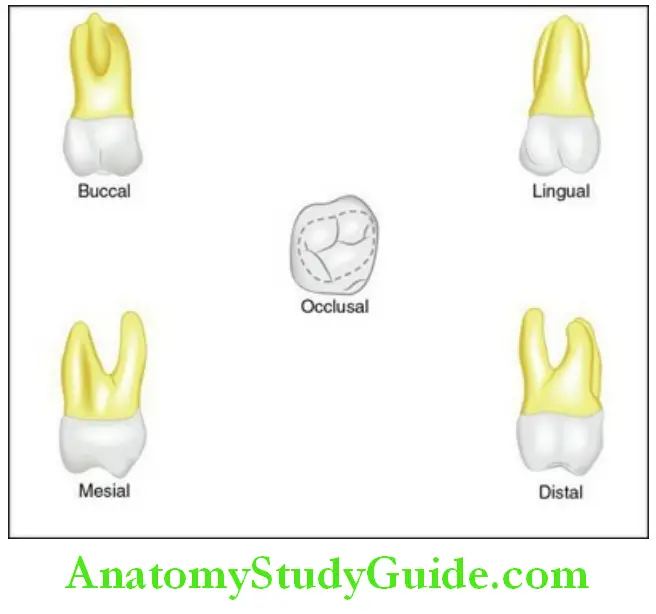
Nomenclature: Maxillary first molar:

Maxillary first molar: Chronology and measurements:

Buccal aspect :
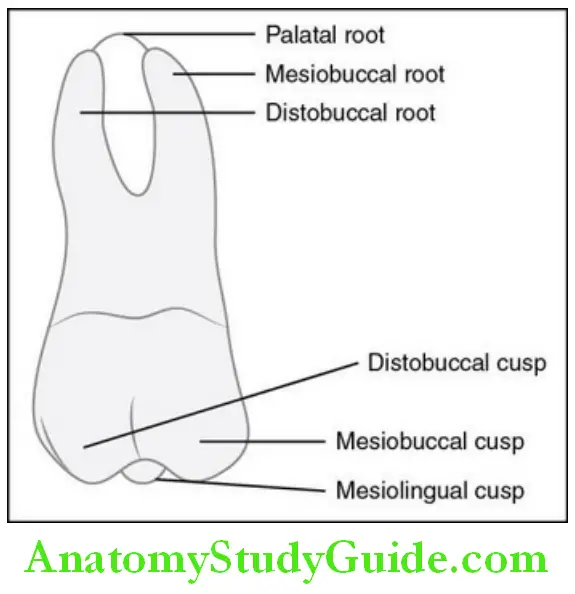
Features of the crown:
- The mesiobuccal and distobuccal cusps and parts of the mesiolingual and Distolingual cusps are seen from this aspect.
- If the tooth is held upright with the line of vision being perpendicular to the buccal developmental groove, the distal surface of the crown is seen due to the obtuse distobuccal line angle.
Shape and surface:
- Shape is trapezoidal. It is more constricted at the cervix than at the Occlusal outline.
- The surface has the buccal developmental groove that separates the Buccal cusps.
- The groove is parallel to the long axis of the distobuccal root and in an occlusoapical direction. It becomes shallow as it terminates at a point halfway from its origin to the cervical line where a dip in the enamel may be seen at the termination of the groove.
Mesial outline:
- The mesial outline is straight from the cervical line and curves occlusally as it approaches the mesial contact area. From the mesial contact area, the mesial outline becomes confluent with the mesial slope of the mesiobuccal cusp.
- The mesial contact area is located at the junction of the middle and Occlusal third.
Distal outline:
- The distal outline is convex. A concavity of flattened area may be seen On the distal surface in the cervical third of the crown above the distobuccal cusp.
- The distal contact area is located at the middle of the middle third.
Occlusal outline:
- The mesiobuccal cusp is wider than the distobuccal cusp.
- Each cusp has two slopes, i.e. The mesial slope and the distal slope.
- The two slopes of the mesiobuccal slope meet at an obtuse angle and The two slopes of the distobuccal cusp meet at a right angle. The Distobuccal cusp is thus sharper and sometimes longer than the Mesiobuccal cusp.
Cervical line:
- The cervical line is convex with the convexity directed towards the Root.
Features of the root:
- The roots of the maxillary molar originate as a single root on the base of the crown which is referred to as the root trunk. The single root later divides into the lingual, mesiobuccal and the distobuccal roots.
- Generally, the lingual root is the longest and the two buccal roots are of equal length.
- All the roots are visible from this aspect with the axes of the roots distally inclined.
- Mesiobuccal root:
- The axis of the mesiobuccal root is at right angle to the cervical line. The Root curves distally from the middle third.
- Distobuccal root:
- The long axis of the distobuccal root is at an acute angle to the cervical Line. The root is straighter.
- The bifurcation of the buccal roots is at a point 4 mm above the cervical line.
- A deep developmental groove is present on the root trunk. It extends from the bifurcation to the cervical line terminating in a shallow depression.
Lingual aspect:
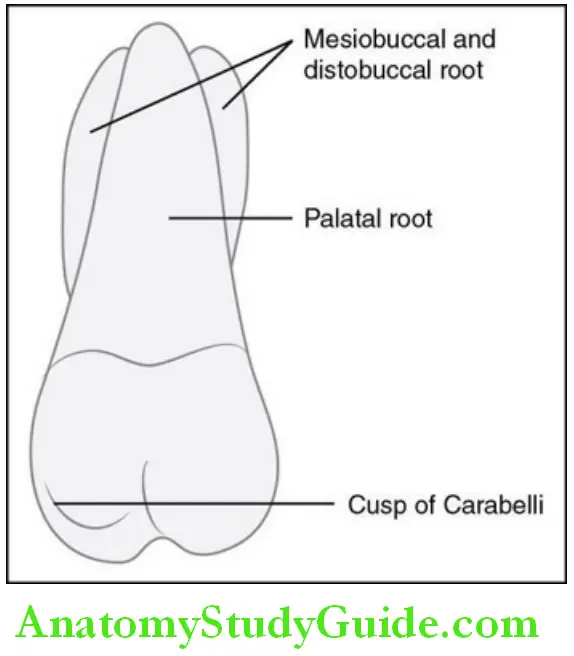
Features of the crown:
- The two lingual cusps, i.e. Mesiolingual and the distolingual cusps are the only cusps seen from this aspect.
- Mesiolingual cusp
- The mesiolingual cusp is the longest and the largest cusp in the tooth Without occlusal wear.
- The width of the mesiolingual cusp is about three-fifth of the Mesiodistal dimension of the crown.
- The angle between the two slopes of the mesiolingual cusp is an obtuse Angle. The angle between the mesial slope of the mesiolingual cusp and the mesial outline of the crown is 90°.
- Distolingual cusp
- The distolingual cusp is round and spheroidal.
- The distal outline of the crown is continuous with the distolingual cusp Creating a semicircular arc.
Shape and surface:
- The lingual outline is reverse of that of the buccal outline and the shape Of the crown is trapezoidal.
- The lingual developmental groove is present between the two lingual Cusps.
- It begins in the centre of the lingual surface and curves distally as it crosses between the lingual cusps and continues onto the occlusal surface.
- It terminates approximately at the centre of the root lingually.
- From this point, a shallow depression extends onto the centre of the lingual root at the cervical line in an apical direction and fades out in the middle third of the lingual root.
Fifth cusp:
- The fifth cusp is called the cusp ofcarabelli
- It is present on the mesiolingual surface of the mesiolingual cusp.
- A fifth cusp groove may separate this cusp from the mesiolingual cusp. The fifth cusp groove is an irregular developmental groove beginning in a depression of the mesiolingual line angle, extending occlusally and terminating in the terminus of the lingual groove.
- If the fifth cusp is well developed, then the cusp ridge of the fifth cusp is approximately 2 mm cervical to that of the mesiolingual cusp.
Features of the root:
- The lingual root makes up majority of the foreground. It is conical in shape with a blunt rounded apex.
- The mesial outline of the mesiobuccal root, distal outline of the distobuccal root above the middle third, and apices of both the buccal roots may be seen.
Mesial aspect:
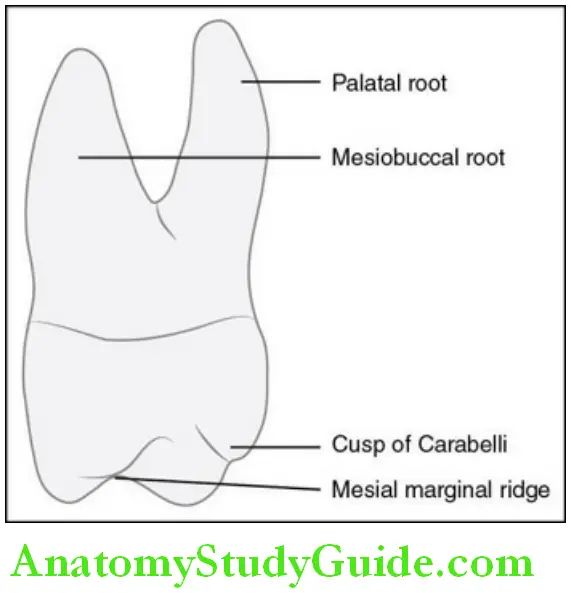
Features of the crown:
On observing the tooth from the mesial aspect with the mesial contact area at right angles to the line of vision, the mesiobuccal, mesiolingual and the fifth cusp are seen.
Shape and surface:
- Increased buccolingual dimension
- Prominent convexities in the cervical third on the buccal and lingual
Outlines are present. - The surface is convex with the mesial contact area located at the
Junction of the middle and the occlusal third, and a shallow concavity
Buccally placed above the mesial contact area extending onto the root In the cervical third is present.
Mesial marginal ridge:
- The mesial marginal ridge curves cervically to one-fifth the crown length and is confluent with the mesiobuccal and mesiolingual cusp ridges.
- Due to the curvature of the mesial marginal ridge a part of the occlusal surface may be seen.
Buccal outline:
- The buccal outline is convex from the cervical line to the buccal crest of Curvature.
- The buccal crest of curvature is located within the cervical third of the Crown.
- A concavity followed by convexity is seen from the crest of curvature To the buccal cusp tip.
Lingual outline:
- The lingual outline is as convex as the buccal outline.
- The lingual crest of curvature is located at the middle of the middle Third.
- As the fifth cusp is underdeveloped, the lingual outline is curved from The crest of curvature to the cusp tip
Features of the root:
- The mesiobuccal and the lingual root are visible. The level of bifurcation is closer to the cervical line than on the buccal aspect.
- Mesiobuccal root:
- The mesiobuccal root is broad buccolingually and the surface is flat With smooth flutings.
- The bifurcation is at approximately two-thirds the measurement of the Crown buccolingually.
- The buccal outline is convex and the lingual outline is straight from the Bifurcation to the blunt apex.
- Lingual root:
- The lingual root is longer and narrower than the mesiobuccal root.
- Its lingual outline is convex and the buccal outline is concave.
- The root tip is more pointed than the mesiobuccal root.
Distal aspect:

Features of the crown:
The distobuccal and the distolingual cusps and a portion of the cusp of carabelli are seen.
The outline is similar to that of the mesial aspect except for the following variations:
- The mesiodistal measurement of the crown is greater mesially than distally as the crown tapers distally on the buccal surface. Due to this most of the buccal surface is seen.
- The triangular ridges are exposed on the distal portion of the occlusal surface of the crown as the distal marginal ridge dips cervically.
- Cervical line is straight buccolingually.
- The distal surface is rounded and convex except for a concavity that continues on the surface of the distobuccal root till the level of the bifurcation.
Features of the root:
- The distobuccal, palatal and the buccal outline of the mesiobuccal root are visible.
- The bifurcation is about 5 mm or beyond from the cervical line and is more Apical on the distal aspect than the other two aspects of the tooth.
Occlusal aspect:

Outline shape and surface:
Outline: Rhomboidal.
- The buccolingual dimension is greater mesially than distally and the mesiodistal dimension is greater lingually than buccally.
- Two acute angles – mesiobuccal and distolingual line angles
- Two obtuse angles – mesiolingual and distobuccal line angles
- Maxillary molar cusp triangle:
- The cusp outlines of the mesiolingual, mesiobuccal, distobuccal cusps, The mesial marginal ridge and the oblique ridge form a triangle on the Outline of the root trunk of the maxillary molars when the teeth are Sectioned. This triangular arrangement of the three major cusps is Called the maxillary molar primary cusp triangle. The distolingual cusp Which is the smallest cusp progressively decreases in size in the second And the third molar and is no longer a major cusp.
Occlusal table: It is within the confines of the crown, i.e. The cusp and marginal ridges.
The occlusal surface comprises cusps, fossae, ridges and grooves which Are described below in table.
Occlusal surface of the maxillary molar:
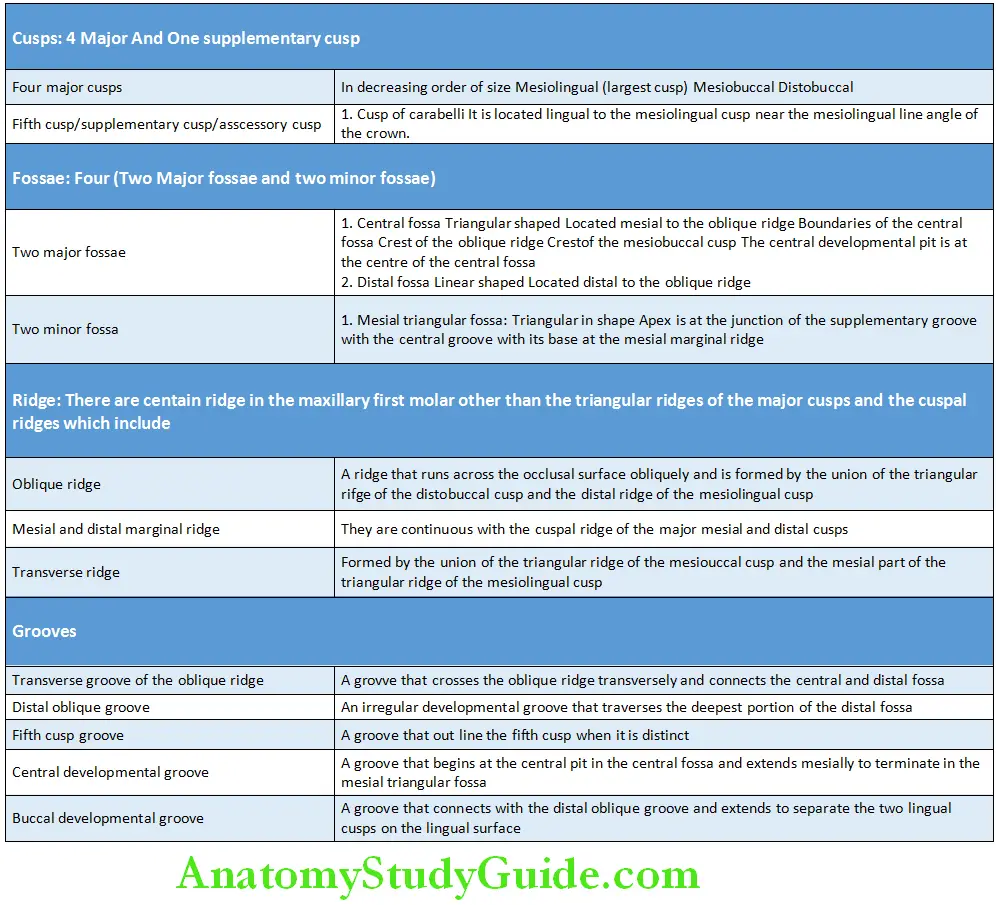
The features that can help in identification of the maxillary first molar are given in box.
Features to identify the maxillary first molar:
- Five cusps and three roots
- Rhomboidal crown outline from the occlusal aspect
- Crown is wider buccolingually than mesiodistally
- Oblique ridge
- Cusp of carabelli
Differentiation Between The Right And Left Maxillary First Molar
- Cusp of carabelli
- The crown is mesially wider than distally and lingually wider than buccally
- Largest cusp is the mesiolingual cusp
- Orientation of the oblique ridge
Development And Landmarks Crown And Root Of The Maxillary First Molar

Variations And Developmental Anomalies
- Presence of extra roots
- Abnormal sharp bend in the root
The Permanent Maxillary First Molars Synopsis
Labial aspect:
Crown:
- Shape is trapezoidal. The surface has the buccal developmental groove that Separates the buccal cusps.
- Mesial outline is straight and becomes confluent with the mesial slope of the mesiobuccal cusp.
- The mesial contact area is located at the junction of the middle and the occlusal third.
- Distal outline is convex. The distal contact area is located at the middle of the middle third.
- The mesiobuccal cusp is wider than the distobuccal cusp.
- Cervical line is convex with the convexity directed towards the root.
Root:
- Lingual, mesiobuccal and the distobuccal roots.
- The lingual root is the longest and the two buccal roots are of equal length.
Lingual aspect:
Crown:
- Mesiolingual cusp is the longest and the largest cusp in the tooth without Occlusal wear.
- Distolingual cusp is round and spheroidal.
- The lingual developmental groove is present between the two lingual cusps.
- Fifth cusp is called the cusp of carabelli. It is present on the mesiolingual surface of the mesiolingual cusp. A fifth cusp groove may separate this cusp from the mesiolingual cusp.
Root:
- The lingual root makes up majority of the foreground. It is conical in shape with a blunt rounded apex.
Mesial aspect:
Crown:
- Convex surface with the mesial contact area located at the junction of the middle and the occlusal third.
- Mesial marginal ridge: Is irregular and curves cervically to one fifth the crown length.
- Buccal outline is convex from the cervical line to the buccal crest of curvature.
- The buccal crest of curvature is located within the cervical third of the crown.
- Lingual outline is as convex as the buccal outline. The lingual crest of curvature is located at the middle of the middle third.
Root:
- Mesiobuccal root is broad buccolingually and the surface is flat with smooth flutings.
- Lingual root is longer and narrower than the mesiobuccal root.
Distal aspect:
Crown:
- The outline is similar to that of the mesial aspect except for the variations:
- The mesiodistal measurement of the crown is greater mesially than distally.
- The triangular ridges are as the distal marginal ridge dips cervically.
- Cervical line is straight buccolingually.
- The distal surface is rounded and convex except for a concavity that continues on the surface of the distobuccal root till the level of the bifurcation.
Root:
- The distobuccal, palatal and the buccal outline of the mesiobuccal root is visible.
- The bifurcation is about 5 mm or beyond from the cervical line and is more apical on the distal aspect than the other two aspects of the tooth.
Occlusal aspect:
- Outline: Rhomboidal.
- The buccolingual dimension is greater mesially than distally and the mesiodistal dimension is greater lingually than buccally.
- Two acute angles – mesiobuccal and distolingual line angles
- Two obtuse angles – mesiolingual and distobuccal line angles
- Four major cusps and one supplementary cusp
- Four fossae (two major fossae and two minor fossae)
- Oblique ridge and a few grooves
The Permanent Maxillary Second Molar
There are two permanent maxillary second molars. They are located distal to the first molar and mesial to the third molar.
Salient features of the maxillary second molar:
- The crown is 0.5 mm shorter cervico-occlusally than the first molar.
- The distobuccal cusp is not well developed and thus smaller.
- Distolingual cusp is smaller.
- The fifth cusp is not present. The morphology of this tooth will be described from the buccal, lingual, mesial, distal and occlusal aspects. The nomenclature, chronology and the measurement of the maxillary first molar are given in tables.

Nomenclature: Maxillary second molar:

Maxillary second molar: Chronology and measurements:
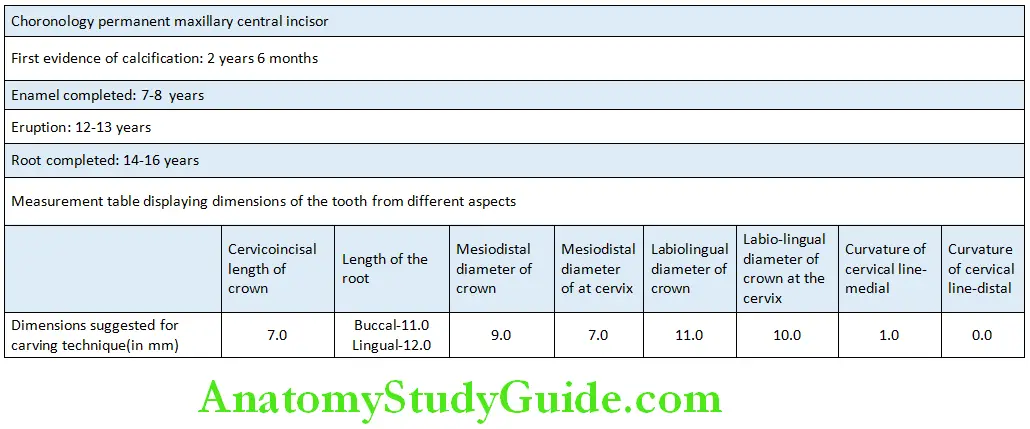
Buccal aspect:

Features of the crown:
Shape and surface:
- The crown is shorter cervico-occlusally and smaller mesiodistally than The first molar.
- The surface is convex.
- The buccal groove separates the buccal cusps and extends half way From it point of origin to the cervical line.
Mesial outline:
- The mesial outline is convex from the cervical line to the mesial slope Of the mesiobuccal cusp.
- The mesial contact area is located at the junction of the middle and Occlusal third.
Distal outline:
- The distal outline is more convex than the mesial outline.
- The distal contact area is located at the middle of middle third.
Occlusal outline:
- The mesiobuccal cusp is longer and wider than the distobuccal cusp.
- The distobuccal cusp is smaller and thus the distolingual cusp and a Portion of the distal marginal ridge is seen.
Cervical line:
- The cervical line is convex with the curvature towards the root.
Features of the root:
- All the three roots are visible, i.e. The distobuccal, mesiobuccal and palatal.
- Two buccal roots are of equal length.
- Mesiobuccal root – the apex is distally tilted and in line with the buccal groove.
- Distobuccal root – the apex is mesially inclined.
Lingual aspect:
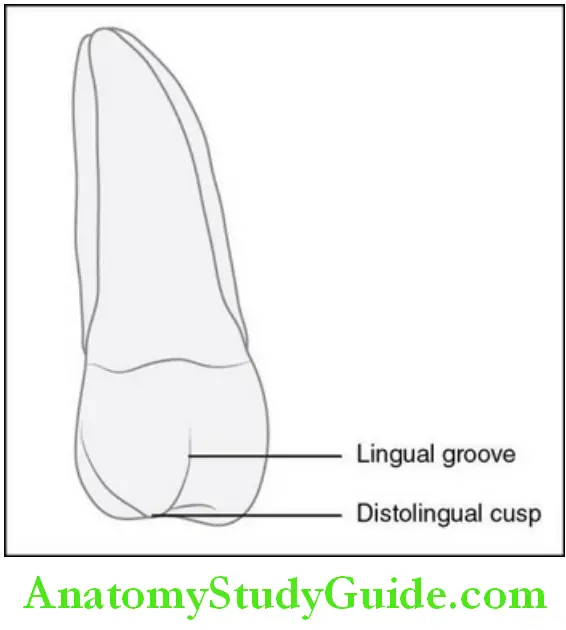
Features of the crown:
- The outline of the crown is the reverse of the labial outline.
- The mesiolingual and distolingual cusps are seen which are separated by the lingual developmental groove; distobuccal cusp may be visible.
- Fifth cusp is absent.
- Mesial outline is convex from the cervical line to mesiolingual cusp.
- Distal outline is more convex than the mesial outline.
Features of the root:
- The tip of the palatal root is line with the cusp tip of the distolingual cusp.
Mesial aspect:
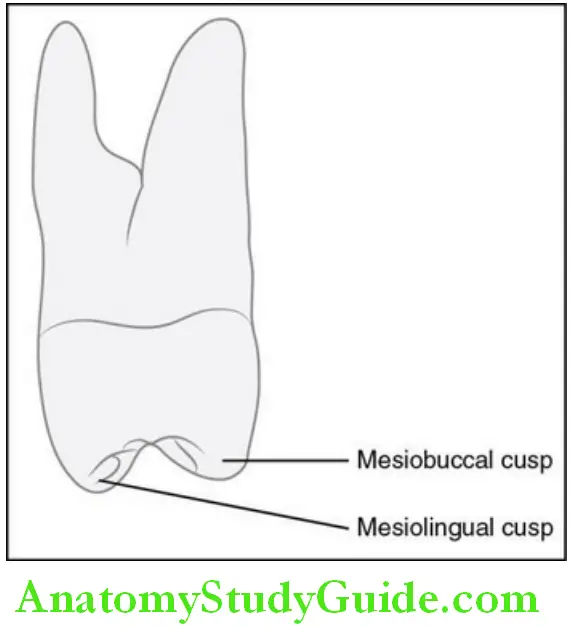
Features of the crown:
The length of the crown is less than that of the first molar. The mesiobuccal, mesiolingual cusps are seen.
Shape and surface:
- Buccolingual dimension is increased.
- Prominent convexities in the cervical third on the buccal and lingual Outlines.
- Mesial marginal ridge: Irregular, curves cervically and confluent with The mesiobuccal and mesiolingual cusp ridges. A part of the occlusal Surface may be seen due to the curvature.
Buccal outline:
- The buccal outline is convex from the cervical line to the buccal crest of Curvature.
- The buccal crest of curvature is located within the cervical third of the Crown.
Lingual outline:
- The lingual outline is more convex than the buccal outline.
- The lingual crest of curvature is located at the middle of the middle Third.
Features of the root:
- The mesiobuccal and the lingual root are visible.
- The roots are less flared compared to that of the first molar and are within the confines of the crown buccolingually.
- Mesiobuccal root:
- The mesiobuccal root is broad buccolingually. The buccal outline is Straight up to the middle third.
- Lingual root:
- The lingual root is longer and narrower than the mesiobuccal root. Its lingual outline is convex and the buccal outline is concave.
Distal aspect:
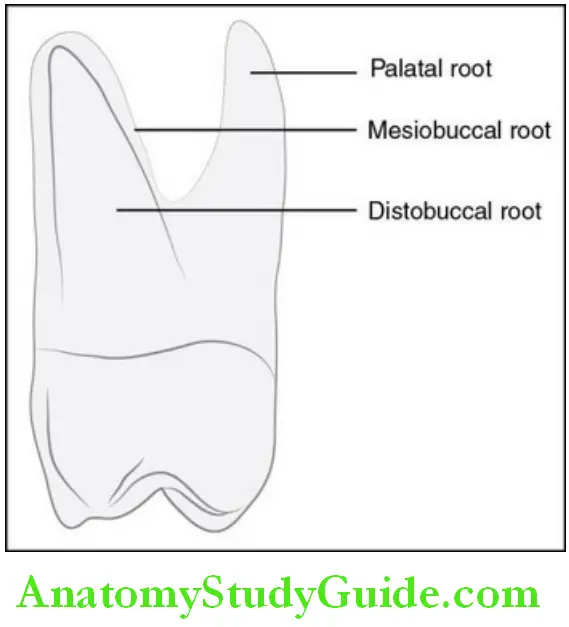
Features of the crown:
The distobuccal and distolingual cusp, part of the mesiolingual cusp and more of the mesiobuccal cusp is seen.
The outline is similar to that of the mesial aspect except for the variations:
- Most of the buccal and lingual surface is seen as the crown is narrower distally than mesially.
- The triangular ridges are exposed on the distal portion of the occlusal surface of the crown as the distal marginal ridge dips cervically.
- Cervical line is straight buccolingually.
- The distal surface is rounded and convex.
Features of the root:
- The distobuccal, mesiobuccal and palatal roots are visible.
- The apex of the lingual root is in line with the distolingual cusp.
Occlusal aspect:
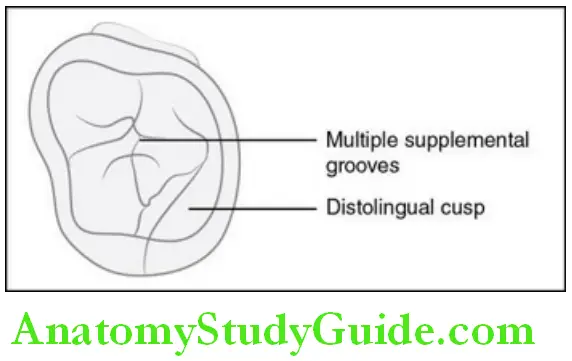
Shape and surface:
- The outline is rhomboidal.
- The acute angles (mesiobuccal and distolingual line angles) are less Acute and the obtuse angles (mesiolingual and distobuccal line angles) Are more obtuse than the maxillary first molar.
- The buccolingual dimension is more than the mesiodistal dimension by 1 mm.
- The mesiolingual cusp is the largest cusp.
- The distobuccal and distolingual cusps are not well developed and are Smaller.
- Supplementary grooves and pits may be seen on the occlusal surface.
- The oblique ridge is less prominent.
- The crown is wider mesially than distally.
Three-cusp type:
- It is of the heart shaped form.
- The distolingual cusp is underdeveloped or almost absent and thus the crown appears heart shaped. The features that can help in identification of the maxillary second molar are given in box.
Features to identify the maxillary second molar:
- Four cusps and three roots
- Less prominent oblique ridge
- Less flaring of the roots
- Absence of the fifth cusp
Differentiation Between The Right And Left Maxillary Second Molar
- Orientation of the oblique ridge
- Crown is wider mesially than distally when viewed from the occlusal aspect
- Small distolingual cusp and larger mesiolingual cusp
Development And Landmarks Crown And Root Of The Maxillary Second Molar
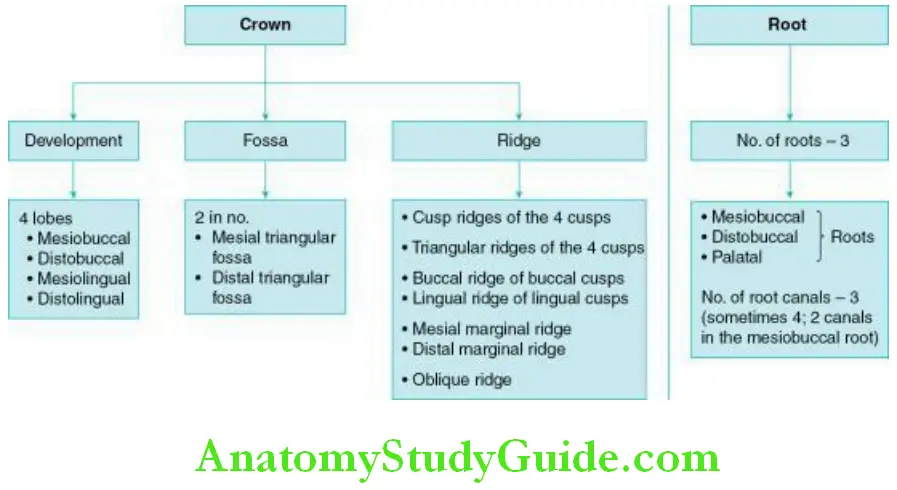
Variations And Developmental Anomalies
- Heart-shaped form – the distolingual cusp is poorly developed and the second molar might resemble the third molar.
- Abnormal sharp bend in the root.
The Permanent Maxillary First Molars Synopsis
Labial aspect:
Crown:
- The crown is shorter cervico-occlusally and smaller mesiodistally than the first molar and the surface is convex.
- Mesial outline is convex. The mesial contact area is located at the junction of the middle and occlusal third.
- Distal outline is more convex than the mesial outline. The distal contact area is located at the middle of middle third.
- The mesiobuccal cusp is longer and wide than the distobuccal cusp.
Root:
- All the three roots are visible, i.e. The distobuccal, mesiobuccal and palatal.
- The buccal roots are of equal length.
Lingual aspect:
Crown:
- The mesiolingual and distolingual cusps are seen which are separated by the lingual developmental groove; distobuccal cusp may be visible.
- Mesial outline is convex.
- Distal outline is more convex.
Root:
- The tip is of the lingual root is in line with the cusp tip of the distolingual cusp.
Mesial aspect:
Crown:
- Buccolingual dimension is increased.
- Mesial marginal ridge is irregular, curves cervically and confluent with the mesiobuccal and mesiolingual cusp ridges.
- Buccal outline is convex from the cervical line to the buccal crest of curvature.
- The buccal crest of curvature is located within the cervical third of the crown.
- Lingual outline is more convex than the buccal outline.
- The lingual crest of curvature is located at the middle of middle third.
Root:
- The mesiobuccal and the lingual root are visible.
- The roots are less flared compared to that in the first molar and are within the confines of the crown.
Distal aspect:
Crown:
The outline is similar to that of the mesial aspect except for the variations:
- Most of the buccal and lingual surface is seen as the crown is narrower distally than mesially.
- The triangular ridges are exposed on the distal portion of the occlusal surface of the crown as the distal marginal ridge dips cervically.
- Cervical line is straight buccolingually.
- The distal surface is rounded and convex.
Root:
- The apex of the lingual root is in line with the distolingual cusp.
Occlusal aspect:
- The outline is rhomboidal.
- The acute angles (mesiobuccal and distolingual line angles) are less acute and the obtuse angles (mesiolingual and distobuccal line angles) are more obtuse than the maxillary first molar.
- The buccolingual dimension is more than mesiodistal dimension by 1 mm.
- The mesiolingual cusp is the largest cusp. The distobuccal and distolingual cusps are not well developed and are smaller.
- Supplementary grooves and pits may be seen on the occlusal surface.
- The oblique ridge is less prominent.
- The crown is wider mesially than distally thus there is more converge distally.
- Three-cusp type: It is of the heart-shaped form. The distolingual cusp is underdeveloped or almost absent and thus the crown appears heart shaped.
The Permanent Maxillary Third Molar
The permanent maxillary third molars are two in number and located distal to the second molar. They supplement the second molar in function. They exhibit considerable variation in size, shape, contour and position in the arch in relation to the other teeth.
The third molars show more variation than all the other teeth in the oral cavity.
Salient features of the maxillary third molars:
- They are often a developmental anomaly.
- Anatomically similar to the second molar.
- The crown and root are smaller and shorter in dimension than the second molar.
- The most common type of third molar seen is the heart-shaped type where the distolingual cusp is poorly developed or sometimes absent. The nomenclature, chronology and the measurement of the maxillary third molar are given in tables.
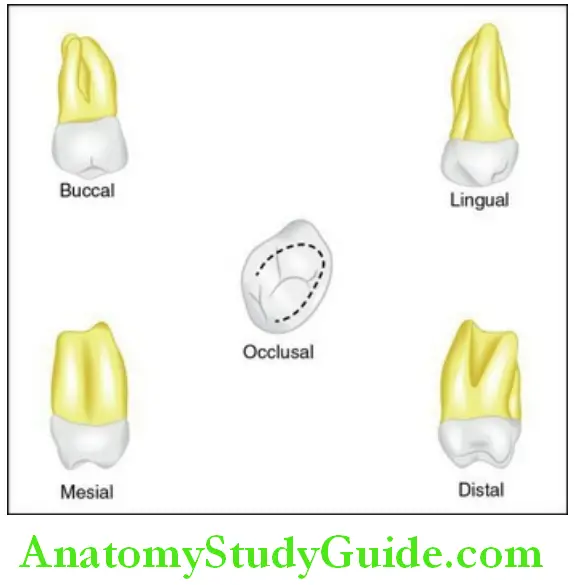
Nomenclature: Maxillary third molar:

Maxillary third molar: Chronology and measurements
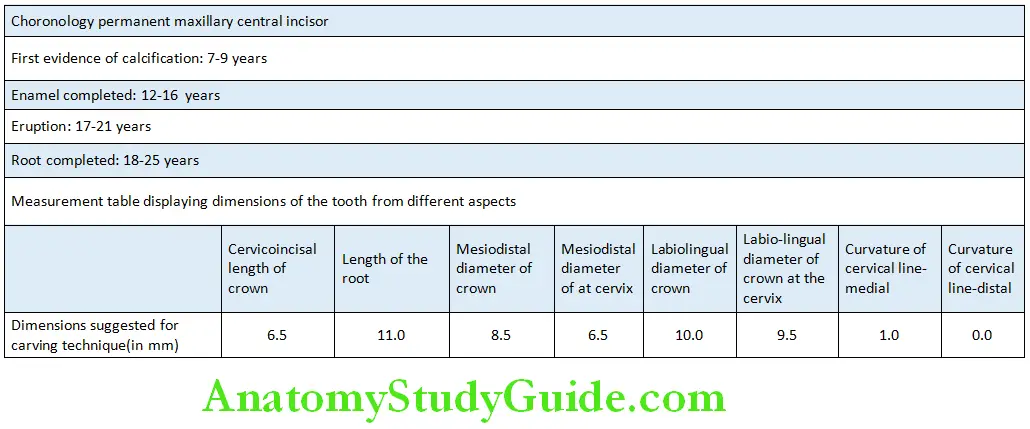
Buccal aspect:
- The crown is shorter cervico-occlusally and mesiodistally narrower.
- Mesial outline:
- The mesial outline is slightly convex.
- The mesial contact area is located at the junction of the middle and Occlusal third.
- Distal outline:
- The distal outline is more convex than the mesial outline.
- The distal contact area is located at the middle of the middle third.
- The mesiobuccal, distobuccal and mesiolingual cusps are seen. The mesiobuccal cusp is wider than the distobuccal cusp.
- Roots could be fused to form one root ending in a tapered apex.
- Roots might exhibit a distal tilt.

Lingual aspect:
One large lingual cusp is present.
- The lingual groove is absent.
- The mesial and distal outlines are convex.
- In some cases, a third molar with a poorly developed distolingual cusp and lingual groove may be present.
- Roots are fused.
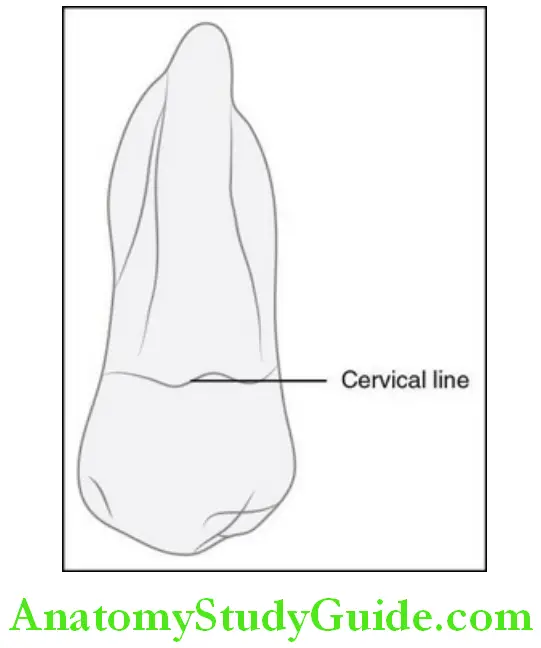
Mesial aspect:
- The crown and root are poorly developed.
- The buccal and lingual outlines are irregular and taper to a fused root with a bifurcation in the apical third.
- Root is short in comparison to the length of the crown.

Distal aspect:
- The distolingual cusp may be absent.
- More of the buccal surface is seen due to the convergence of the crown distally.
- Most of the occlusal surface is seen due to the angulation of the occlusal surface with the long axis of the tooth.
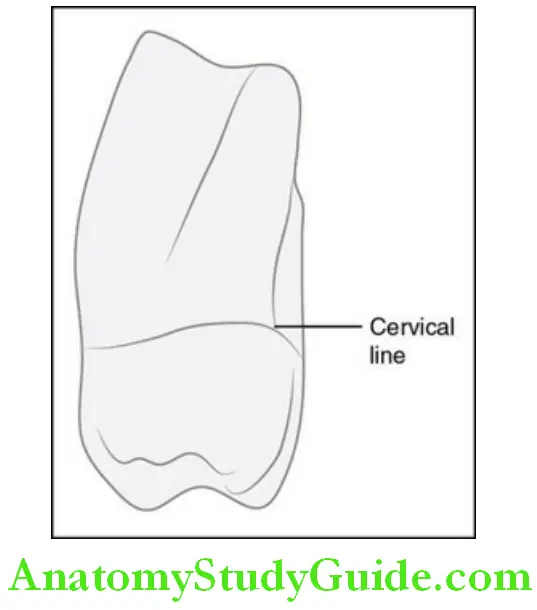
Occlusal aspect:
Most common outline is heart shaped.
- Three functional cusps, i.e. Two buccal and one lingual cusp are seen.
- The crown converges lingually.
- The lingual cusp is well developed and large.
- Distolingual cusp is poorly developed or may be absent.
- Supplementary grooves are seen on the occlusal aspect.
- A four-cusp form might also be seen with the presence of an oblique ridge; this tooth is similar to the second molar. The features that can help in identification of the maxillary third molar are given in box.
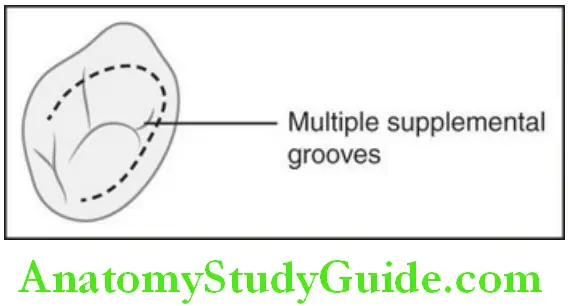
Features to identify the maxillary third molar:
- Heart-shaped outline of the crown
- Distolingual cusp is small or absent
- Numerous supplementary grooves on the occlusal surface
- Overall small size of the root
- Fused roots
Development And Landmarks Crown And Root Of The Maxillary Third Molar

Variations And Developmental Anomalies
- Well-developed tooth resembling the maxillary second molar
- Very short crown and root
- Fused roots
- Distally tilted roots
- The tooth might appear to be an anomaly due to great variations
The Permanent Maxillary First Molars Synopsis
Labial aspect:
Crown:
- The crown is shorter cervico-occlusally and mesiodistally narrower.
- Mesial outline is slightly convex. The mesial contact area is located at the junction of the middle and occlusal third.
- Distal outline is more convex than the mesial outline. The distal contact area is located at the middle of the middle third.
- The mesiobuccal, distobuccal and mesiolingual cusps are seen. The mesiobuccal cusp is wider than the distobuccal cusp.
Roots:
- They could be fused to form one root ending in a tapered apex.
- Roots might exhibit a distal tilt.
Lingual aspect:
- One large lingual cusp is present.
- The lingual groove is absent.
- The mesial and distal outlines are convex.
- In some cases, a third molar with a poorly developed distolingual cusp and lingual groove may be present.
- Roots are fused.
Mesial aspect:
- The crown and root are poorly developed.
- The buccal and lingual outlines are irregular and taper to a fused root with a bifurcation in the apical third.
- Root is short in comparison to the length of the crown.
Distal aspect:
- The distolingual cusp may be absent.
- More of the buccal surface is seen due to the convergence of the crown distally.
- Most of the occlusal surface is seen due to the angulation of the occlusal surface with the long axis of the tooth.
Occlusal aspect:
- Most common outline is heart shaped.
- Three functional cusps, i.e. Two buccal and one lingual cusp are seen. The crown converges lingually.
- The lingual cusp is well developed and large.
- Distolingual cusp is poorly developed or may be absent.
- Supplementary grooves are seen on the occlusal aspect.
- A four-cusp form might also be seen with the presence of an oblique ridge; this tooth is similar to the second molar.
Leave a Reply